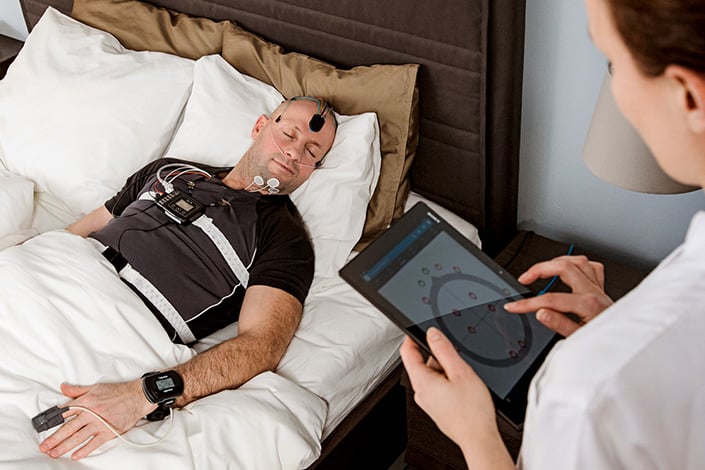ResMed is committed to sharing its in-depth knowledge of obstructive sleep apnea (OSA) screening.
If your patient displays symptoms of sleep-disordered breathing, we can help you accurately refer your patient for an OSA diagnosis.
Ask your patient to undergo a sleep apnea screening test by completing a symptom questionnaire or by using a home sleep screening device.
Based on the results of the screening, recommend a sleep study for your patient to monitor and determine the severity of their OSA.
Sleep studies should be performed in the patient’s home or at a sleep clinic, in line with local rules and regulations.
During a sleep study, your patient’s breathing, body movements and responses during the night are monitored to see if them has a sleep disorder such as sleep apnea.
Below is some information you can pass on to your patients about what happens during a sleep study.
In a clinic, hospital or sleep lab, clinical staff will place sensors on your patient’s body to monitor their sleep.
Sensors are placed:
Patients will also be fitted with:
With your patient’s permission, staff may also ask to film the sleep study to gain more insights into the patient’s sleeping behaviour.
During this type of study, your patient will be required to stay overnight at the facility, so they should take everything needed for their usual sleeping routine, including pyjamas and toiletries.

Among other things, the sleep study will indicate the severity of your patient’s condition, which is classified using the apnea/hypopnea index (AHI).
The AHI score indicates the number of apneas and hypopneas your patient has per hour (<5 to 30+).1
| Severity | AHI (per hour) |
|---|---|
| Normal | <5 |
| Mild | 5 to <15 |
| Moderate | 15 to <30 |
| Severe | 30+ |
In addition to the patient’s AHI, the diagnosis will take into account the patient’s oxygen desaturation and in case of OSA, excessive daytime sleepiness.
Once you receive your patient’s sleep study results, you can then talk to them about the condition (if it’s present), its severity, its possible health effects and treatment options.
American Academy of Sleep Medicine, Sleep-related breathing disorders in adults: recommendations for syndrome definition and measurement techniques in clinical research. The Report of an American Academy of Sleep Medicine Task Force. Sleep, 1999. 22(5): p.667-89.
American Academy of Sleep Medicine, Sleep-related breathing disorders in adults: recommendations for syndrome definition and measurement techniques in clinical research. The Report of an American Academy of Sleep Medicine Task Force. Sleep, 1999. 22(5): p.667-89.